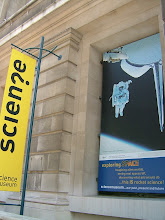The proton shrinks in size
Tiny change in radius has huge implications.
Geoff Brumfiel
Measurements with lasers have revealed that the proton may be a touch smaller than predicted by current theories.PSI / F. Reiser
The proton seems to be 0.00000000000003 millimetres smaller than researchers previously thought, according to work published in today's issue of Nature1.
The difference is so infinitesimal that it might defy belief that anyone, even physicists, would care. But the new measurements could mean that there is a gap in existing theories of quantum mechanics. "It's a very serious discrepancy," says Ingo Sick, a physicist at the University of Basel in Switzerland, who has tried to reconcile the finding with four decades of previous measurements. "There is really something seriously wrong someplace."
Protons are among the most common particles out there. Together with their neutral counterparts, neutrons, they form the nuclei of every atom in the Universe. But despite its everday appearance, the proton remains something of a mystery to nuclear physicists, says Randolf Pohl, a researcher at the Max Planck Institute of Quantum Optics in Garching, Germany, and an author on the Nature paper. "We don't understand a lot of its internal structure," he says.
From afar, the proton looks like a small point of positive charge, but on much closer inspection, the particle is more complex. Each proton is made of smaller fundamental particles called quarks, and that means its charge is roughly spread throughout a spherical area.
Physicists can measure the size of the proton by watching as an electron interacts with a proton. A single electron orbiting a proton can occupy only certain, discrete energy levels, which are described by the laws of quantum mechanics. Some of these energy levels depend in part on the size of the proton, and since the 1960s physicists have made hundreds of measurements of the proton's size with staggering accuracy. The most recent estimates, made by Sick using previous data, put the radius of the proton at around 0.8768 femtometres (1 femtometre = 10-15 metres).
Small wonder
Pohl and his team have a come up with a smaller number by using a cousin of the electron, known as the muon. Muons are about 200 times heavier than electrons, making them more sensitive to the proton's size. To measure the proton radius using the muon, Pohl and his colleagues fired muons from a particle accelerator at a cloud of hydrogen. Hydrogen nuclei each consist of a single proton, orbited by an electron. Sometimes a muon replaces an electron and orbits around a proton. Using lasers, the team measured relevant muonic energy levels with extremely high accuracy and found that the proton was around 4% smaller than previously thought.
ADVERTISEMENT
That might not sound like much, but the difference is so far from previous measurements that the researchers actually missed it the first two times they ran the experiment in 2003 and 2007. "We thought that our laser system was not good enough," Pohl says. In 2009, they looked beyond the narrow range in which they expected to see the proton radius and saw an unmistakable signal.
"What gives? I don't know," says Sick. He says he believes the new result, but that there is no obvious way to make it compatible with years of earlier measurements.
"Something is missing, this is very clear," agrees Carl Carlson, a theoretical physicist at the College of William & Mary in Williamsburg, Virginia. The most intriguing possibility is that previously undetected particles are changing the interaction of the muon and the proton. Such particles could be the 'superpartners' of existing particles, as predicted by a theory known as supersymmetry, which seeks to unite all of the fundamental forces of physics, except gravity.
But, Carlson says, "the first thing is to go through the existing calculations with a fine tooth comb". It could be that an error was made, or that approximations made in existing quantum calculation simply aren't good enough. "Right now, I'd put my money on some other correction," he says. "It's also where my research time will be going over the next month."
From:http://www.nature.com/news/2010/100707/full/news.2010.337.html
skip to main |
skip to sidebar


Cambridge University Press

Books






站在巨人的肩膀上 追尋著愛奧尼亞式迷情的源頭 找尋著存在的意義 心靈最深層的印記 烙印著傳承的使命 隨著宇宙萬物幻化 開啟不朽之殿堂

網誌存檔
Cambridge University Press

Cambridge University Press
Books

Books
Physics

British Musuem

Greenwich Observer

Science Museum

Adventurer

2008

沒有留言:
張貼留言